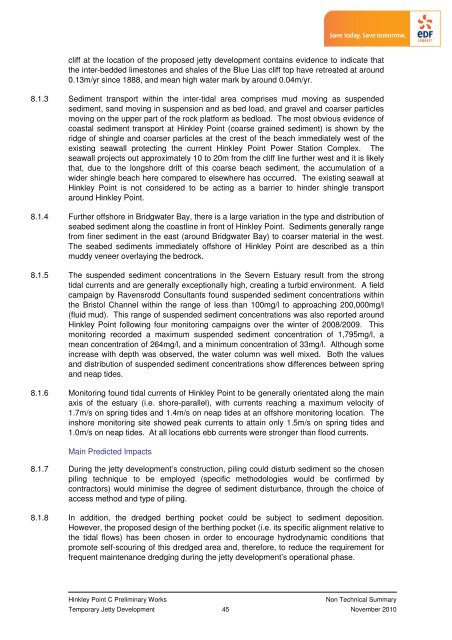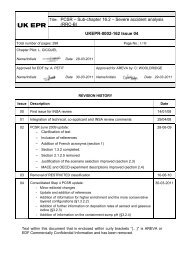Jetty Non Technical Summary - EDF Hinkley Point
Jetty Non Technical Summary - EDF Hinkley Point
Jetty Non Technical Summary - EDF Hinkley Point
You also want an ePaper? Increase the reach of your titles
YUMPU automatically turns print PDFs into web optimized ePapers that Google loves.
cliff at the location of the proposed jetty development contains evidence to indicate that<br />
the inter-bedded limestones and shales of the Blue Lias cliff top have retreated at around<br />
0.13m/yr since 1888, and mean high water mark by around 0.04m/yr.<br />
8.1.3 Sediment transport within the inter-tidal area comprises mud moving as suspended<br />
sediment, sand moving in suspension and as bed load, and gravel and coarser particles<br />
moving on the upper part of the rock platform as bedload. The most obvious evidence of<br />
coastal sediment transport at <strong>Hinkley</strong> <strong>Point</strong> (coarse grained sediment) is shown by the<br />
ridge of shingle and coarser particles at the crest of the beach immediately west of the<br />
existing seawall protecting the current <strong>Hinkley</strong> <strong>Point</strong> Power Station Complex. The<br />
seawall projects out approximately 10 to 20m from the cliff line further west and it is likely<br />
that, due to the longshore drift of this coarse beach sediment, the accumulation of a<br />
wider shingle beach here compared to elsewhere has occurred. The existing seawall at<br />
<strong>Hinkley</strong> <strong>Point</strong> is not considered to be acting as a barrier to hinder shingle transport<br />
around <strong>Hinkley</strong> <strong>Point</strong>.<br />
8.1.4 Further offshore in Bridgwater Bay, there is a large variation in the type and distribution of<br />
seabed sediment along the coastline in front of <strong>Hinkley</strong> <strong>Point</strong>. Sediments generally range<br />
from finer sediment in the east (around Bridgwater Bay) to coarser material in the west.<br />
The seabed sediments immediately offshore of <strong>Hinkley</strong> <strong>Point</strong> are described as a thin<br />
muddy veneer overlaying the bedrock.<br />
8.1.5 The suspended sediment concentrations in the Severn Estuary result from the strong<br />
tidal currents and are generally exceptionally high, creating a turbid environment. A field<br />
campaign by Ravensrodd Consultants found suspended sediment concentrations within<br />
the Bristol Channel within the range of less than 100mg/l to approaching 200,000mg/l<br />
(fluid mud). This range of suspended sediment concentrations was also reported around<br />
<strong>Hinkley</strong> <strong>Point</strong> following four monitoring campaigns over the winter of 2008/2009. This<br />
monitoring recorded a maximum suspended sediment concentration of 1,795mg/l, a<br />
mean concentration of 264mg/l, and a minimum concentration of 33mg/l. Although some<br />
increase with depth was observed, the water column was well mixed. Both the values<br />
and distribution of suspended sediment concentrations show differences between spring<br />
and neap tides.<br />
8.1.6 Monitoring found tidal currents of <strong>Hinkley</strong> <strong>Point</strong> to be generally orientated along the main<br />
axis of the estuary (i.e. shore-parallel), with currents reaching a maximum velocity of<br />
1.7m/s on spring tides and 1.4m/s on neap tides at an offshore monitoring location. The<br />
inshore monitoring site showed peak currents to attain only 1.5m/s on spring tides and<br />
1.0m/s on neap tides. At all locations ebb currents were stronger than flood currents.<br />
Main Predicted Impacts<br />
8.1.7 During the jetty development’s construction, piling could disturb sediment so the chosen<br />
piling technique to be employed (specific methodologies would be confirmed by<br />
contractors) would minimise the degree of sediment disturbance, through the choice of<br />
access method and type of piling.<br />
8.1.8 In addition, the dredged berthing pocket could be subject to sediment deposition.<br />
However, the proposed design of the berthing pocket (i.e. its specific alignment relative to<br />
the tidal flows) has been chosen in order to encourage hydrodynamic conditions that<br />
promote self-scouring of this dredged area and, therefore, to reduce the requirement for<br />
frequent maintenance dredging during the jetty development’s operational phase.<br />
<strong>Hinkley</strong> <strong>Point</strong> C Preliminary Works<br />
<strong>Non</strong> <strong>Technical</strong> <strong>Summary</strong><br />
Temporary <strong>Jetty</strong> Development 45 November 2010














![6.3 - Safety Injection System (RIS [SIS]) - EDF Hinkley Point](https://img.yumpu.com/42739985/1/184x260/63-safety-injection-system-ris-sis-edf-hinkley-point.jpg?quality=85)


